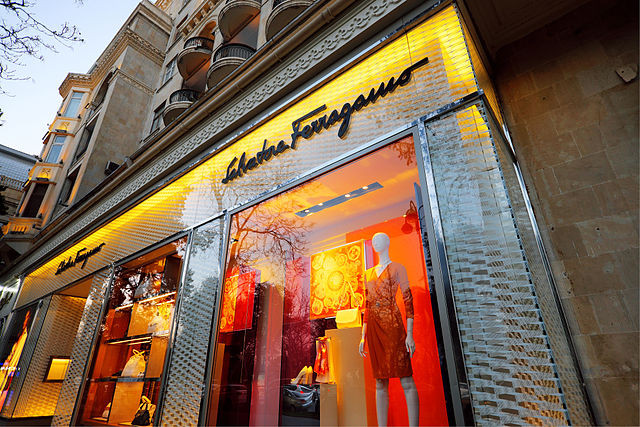Salvatore Ferragamo's fortunes are dwindling.
The Italian luxury brand Salvatore Ferragamo recently released its financial report for the first half of 2023. For the six months ending June 30, revenues decreased by 4.8% to 600 million Euros (approximately 4.7 billion yuan), representing a 7.2% decrease when calculated at a constant exchange rate. The company's net profits and earnings before interest, taxes, depreciation, and amortization (EBITDA) plunged 65.4% and 25.6% respectively.
Geographically, Ferragamo's sales revenues in Asia-Pacific markets excluding Japan fell by 12.9% to 190 million Euros, primarily due to sluggish tourism-related retail sales and a slowdown in the Korean market. Although the Chinese market experienced positive growth, the company argued this simply reflects a return to normal market conditions after the significant impact of the pandemic in 2022, and does not necessarily indicate increased consumer approval of the brand's transformation.
In Japan, sales revenues dropped by 11.4% to 45.4 million Euros, while North American markets declined 17.3% to 160 million Euros. North America and Asia-Pacific markets, which contribute more than half of Ferragamo's revenues, are cited as the main reasons for the company's revenue decline in the first half of 2023, attributed to the lethargic North American luxury goods market.
The only bright spot came from the Europe, Middle East, and Africa region, with a sales revenue increase of 10.8% to 150 million Euros. In the South American market, sales revenue saw a marginal rise of 0.4% to 40.3 million Euros.
Category-wise, Ferragamo's performance in the first half of 2023 was more somber.
Sales of shoes, the category upon which Ferragamo was founded, dropped 4.6% to 270 million Euros. The first series from new creative director Maximilian Davis was launched during the Spring Festival, yet sales revenues for clothing and leather goods categories declined by 3.1% and 13.6% to 38.8 million Euros and 230 million Euros respectively.
Revitalizing the leather goods category and launching popular handbags are the goals of all luxury brands undergoing a transformation, but Ferragamo has seen the greatest decline in this area in the first half of the year. CEO Marco Gobbetti defended the situation, stating the brand transformation has actually achieved some success and maintains the ambitious goal he set in 2022 to double Ferragamo's annual revenue within 4 to 5 years.
In 2022, Ferragamo's sales revenue grew by 10.2% to 1.252 billion Euros, even with a slowdown in the Chinese market in the first half of the year, where sales grew by 20.3% to 630 million Euros. Davis's first show after taking office was launched in September of the same year, and it was expected to further boost Ferragamo's performance.
Yet the challenges facing Ferragamo's transformation seem formidable. Considering its Italian peers, the company's performance in the first half of 2023 doesn't look favorable.
Prada Group's sales revenue for the first half of 2023 increased by 20% to 2.232 billion Euros, with Prada and Miu Miu growing by 18% and 50% respectively. Meanwhile, Ermenegildo Zegna Group and Tod's Group, previously on par with Ferragamo with annual revenues around 1 billion Euros, saw their revenues rise by 23.9% and 21.7% respectively, with Zegna Group's sales hitting 903 million Euros.
Nearly all luxury brands, including LVMH and Kering, emphasized the sluggish American luxury market in their financial reports, but they were compensated by strong growth in Asia-Pacific and European markets. Ferragamo, however, struggled not only in the U.S. but also in the Asia-Pacific market, which should have given it a boost.
The clock is ticking for Ferragamo.
Those who were once willing to allocate prime retail spaces to Ferragamo, such as high-end commercial project operators, are now running out of patience. Ferragamo stores in Beijing SKP and Beijing Wangfujing have been replaced by LOEWE and Prada respectively, while Ferragamo was relocated to the basement in Nanjing Deji Plaza.
The primary reason for this predicament is that consumers still struggle to recognize the brand's value.
For a considerable period, Ferragamo failed to impress with its clothing collections, and it's been hard to find in the popular handbag competition in recent years. Among the few memorable changes might be the departure of former creative director Paul Andrew and the appointment of Maximilian Davis.
In the minds of many consumers, Ferragamo remains an accessories brand.
Female consumers purchase classic shoes, while male consumers are fond of belts decorated with the Gancini buckle. But compared to handbags, the shoe and belt markets are scattered and competitive, making it challenging for the brand to raise premiums in these categories. This not only blurs consumer focus but also ages Ferragamo's image, causing difficulties in the competitive luxury market.
But that's not the only issue. Lackluster design and an outdated image can still be attributed to an "old money" style, but Ferragamo's intrinsic value has been progressively diluted. Consumers perceive the brand for its belts and shoes, but frequent discounts in outlet stores and third-party wholesale channels have diluted its value even further.
When explaining the decline in sales revenue in Asian markets, Ferragamo blamed poor performance in travel retail. But if a luxury brand is so significantly impacted by travel retail, it suggests a dependence on consumers who buy for souvenirs or those seeking a price differential.
These consumers are price-sensitive, disloyal, and unreliable. The past three years of pandemic have shown the impact of relying on travel retail. This phenomenon also reveals that Ferragamo's past strategy of opening large flagship stores in the core business districts of cities has failed to attract and retain consumers effectively.
People know that Ferragamo is transforming and can visibly see its products and advertisements becoming more fashionable, and its refurbished stores becoming more refined. But its value as a luxury brand has been diluted in the past, and the utility of a new image has been discounted as a result. This is why its performance has been inconsistent after starting its transformation. Consumers have yet to build lasting confidence in the brand.






